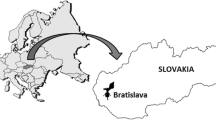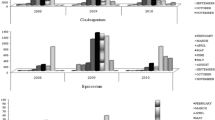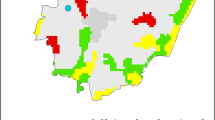Abstract
Although fungal spores are an ever-present component of the atmosphere throughout the year, their concentration oscillates widely. This work aims to establish correlations between fungal spore concentrations in Porto and Amares and meteorological data. The seasonal distribution of fungal spores was studied continuously (2005–2007) using volumetric spore traps. To determine the effect of meteorological factors (temperature, relative humidity and rainfall) on spore concentration, the Spearman rank correlation test was used. In both locations, the most abundant fungal spores were Cladosporium, Agaricus, Agrocybe, Alternaria and Aspergillus/Penicillium, the highest concentrations being found during summer and autumn. In the present study, with the exception of Coprinus and Pleospora, spore concentrations were higher in the rural area than in the urban location. Among the selected spore types, spring-autumn spores (Coprinus, Didymella, Leptosphaeria and Pleospora) exhibited negative correlations with temperature and positive correlations both with relative humidity and rainfall level. On the contrary, late spring-early summer (Smuts) and summer spores (Alternaria, Cladosporium, Epicoccum, Ganoderma, Stemphylium and Ustilago) exhibited positive correlations with temperature and negative correlations both with relative humidity and rainfall level. Rust, a frequent spore type during summer, had a positive correlation with temperature. Aspergillus/Penicillium, showed no correlation with the meteorological factors analysed. This knowledge can be useful for agriculture, allowing more efficient and reliable application of pesticides, and for human health, by improving the diagnosis and treatment of respiratory allergic disease.






Similar content being viewed by others
References
Angulo-Romero J, Mediavilla-Molina A, Domínguez-Vilches E (1999) Conidia of Alternaria in the atmosphere of the city of Cordoba, Spain in relation to meteorological parameters. Int Arch Allergy Immunol 43:45–49
Bruno A, Pace L, Tomassetti B, Coppola E, Verdecchia M, Pacioni G, Visconti G (2007) Estimation of fungal spore concentrations associated to meteorological variables. Aerobiologia 23:221–228. doi:10.1007/s10453–007–9066-y
Burch M, Levetin E (2002) Effects of meteorological conditions on spore plumes. Int Arch Allergy Immunol 46:107–117
Corden J, Millington W (2001) The long-term trends and seasonal variation of the aeroallergen Alternaria in Derby. UK Aerobiologia 17:127–136. doi:10.1023/A:1010876917512
Damialis A, Gioulekas D (2006) Airborne allergenic fungal spores and meteorological factors in Greece: forecasting possibilities. Grana 45:122–129. doi:10.1080/00173130600601005
Fernández D, Valencia R, Molnár T, Vega A, Sagüés E (1998) Daily and seasonal variations of Alternaria and Cladosporium airborne spores in León (North-West, Spain). Aerobiologia 14:215–220. doi:10.1007/BF02694209
Gillum S, Levetin E (2008) The air spora close to a compost facility in Northeast Oklahoma: Part I—spore trap sampling. Aerobiologia 24:3–12. doi:10.1007/s10453–007–9074-y
Giner M, Garcia J, Camacho C (2001) Airborne Alternaria spores in SE Spain (1993–98): Occurrence patterns, relationship with weather variables and prediction models. Grana 40:111–118. doi:10.1080/00173130152625842
Gonzalo M, Paredes M, Muñoz A, Tormo R, Silva I (1997) Dinámica de dispersión de basidiosporas en la atmósfera de Badajoz. Rev Esp Alergol Inmunol Clin 12:294–300
Guinea J, Peláez T, Alcalá L, Bouza E (2006) Outdoor environmental levels of Aspergillus spp. conidia over a wide geographical area. Med Mycol 44:349–356. doi:10.1080/13693780500488939
Hasnain Sm, Fatima K, Al-Frayh A, Al-Sedairy St (2005) One-year pollen and spore calendars of Saudi Arabia: Al-Khobar, Abha and Hofuf. Aerobiologia 21:241–247. doi:10.1007/s10453–005–9000–0
Henriquez V, Villegas G, Nolla J (2001) Airborne fungi monitoring in Santiago, Chile. Aerobiologia 17:137–142. doi:10.1023/A:1010833101583
Herrero A, Ruiz S, Bustillo M, Morales P (2006) Study of airborne fungal spores in Madrid, Spain. Aerobiologia 22:133–140. doi:10.1007/s10453–006–9025-z
Kasprzyk I, Worek M (2006) Airborne fungal spores in urban and rural environments in Poland. Aerobiologia 22:169–176. doi:10.1007/s10453–006–9029–8
Katial R, Zhang Y, Jones R, Dyer P (1997) Atmospheric mold spore counts in relation to meteorological parameters. Int J Biometeorol 41:17–22. doi:10.1007/s004840050048
Lacey M, West J (2006) The air spora. Springer, Dordrecht
Li D-W, Kendrick B (1995) A year-round study on functional relationships of airborne fungi with meteorological factors. Int J Biometeorol 39:74–80. doi:10.1007/BF01212584
Meteorologia (1992) Normais climatológicas 1961–1990 (Serra do Pilar) (Meteorologia, I.d. (ed) Instituto de Meteorologia, Lisboa, pp 1–3
Mitakakis T, Guest D (2001) A fungal spore calendar for the atmosphere of Melbourne, Australia, for the year 1993. Aerobiologia 17:171–176fs. doi:10.1023/A:1011028412526
Molina A, Angulo Romero J, Garcia-Pantaleon I, Comtois P, Vilches E (1998) Preliminary statistical modeling of the presence of two conidial types of Cladosporium in the atmosphere of Cordoba, Spain. Aerobiologia 14:229–234. doi:10.1007/BF02694211
Mullins J, Hutcheson P, Slavin R (1984) Aspergillus fumigatus spore concentration in outside air: Cardiff and St Louis compared. Clin Exp Allergy 14:351–354. doi:10.1111/j.1365–2222.1984.tb02215.x
Myszkowska D, Stepalska D, Obtulowicz K, Porebski G (2002) The relationship between airborne pollen and fungal spore concentrations and seasonal pollen allergy symptoms in Cracow in 1997–1999. Aerobiologia 18:153–161. doi:10.1023/A:1020603717191
Nilsson S (1983) Atlas of airborne fungal spores in Europe. Springer, Heidelberg
Oliveira M, Ribeiro H, Abreu I (2005) Annual variation of fungal spores in the atmosphere of Porto: 2003. Ann Agric Environ Med 12:309–315
Pepeljnjak S, Segvi M (2003) Occurrence of fungi in air and on plants in vegetation of different climatic regions in Croatia. Aerobiologia 19:11–19. doi:10.1023/A:1022693032075
Rodríguez-Rajo F, Iglesias I, Jato V (2005) Variation assessment of airborne Alternaria and Cladosporium spores at different bioclimatical conditions. Mycol Res 109:497–507a. doi:10.1017/S0953756204001777
Rosas I, Escamilla B, Calderon C, Mosiño P (1990) The daily variations of airborne fungal spores in Mexico City. Aerobiologia 6:153–158. doi:10.1007/BF02539108
Rosas I, Calderon C, Ulloa M, Lacey J (1993) Abundance of airborne penicillium CFU in relation to urbanization in Mexico City. Appl Environ Microbiol 58:2648–2652
Sabariego S, Díaz De La Guardia C, Alba F (2000) The effect of meteorological factors on the daily variation of airborne fungal spores in Granada (southern Spain). Int J Biometeorol 44:1–5. doi:10.1007/s004840050131
Troutt C, Levetin E (2001) Correlation of spring spore concentrations and meteorological conditions in Tulsa, Oklahoma. Int J Biometeorol 45:64–74. doi:10.1007/s004840100087
Acknowledgements
The authors are grateful to Prof. Dr. Manuel de Barros, from the Instituto Geofísico da Universidade do Porto, and Eng. Guerner-Moreira, from the Direcção Regional de Agricultura e Pescas do Norte - Divisão de Protecção e Controle Fitossanitário, for the meteorological data provided. This work was partially supported by Fundação Calouste Gulbenkian (project: 77161) and a grant from the Fundação para a Ciência e Tecnologia (SFRH/BD/18765/2004).
Author information
Authors and Affiliations
Corresponding author
Rights and permissions
About this article
Cite this article
Oliveira, M., Ribeiro, H., Delgado, J.L. et al. The effects of meteorological factors on airborne fungal spore concentration in two areas differing in urbanisation level. Int J Biometeorol 53, 61–73 (2009). https://doi.org/10.1007/s00484-008-0191-2
Received:
Revised:
Accepted:
Published:
Issue Date:
DOI: https://doi.org/10.1007/s00484-008-0191-2




